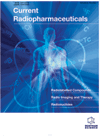- Home
- A-Z Publications
- Current Radiopharmaceuticals
- Previous Issues
- Volume 4, Issue 3, 2011
Current Radiopharmaceuticals - Volume 4, Issue 3, 2011
Volume 4, Issue 3, 2011
-
-
Editorial [Hot Topic: Targeted Alpha Therapy - Part I (Guest Editor: Jorgen Elgqvist)]
More LessThe Magic-Bullet: Moving the Concept Towards Reality - Part I The possibility of pinpointing biological targets, and thereby potentially targeting and eradicating small tumors or even single cancer cells, is a tantalizing concept that has been discussed since the magic-bullet concept was first presented by Paul Erlich in the beginning of the 20th century in connection with his work on tissue staining for histological examinations Read More
-
-
-
Astatine-211: Production and Availability
More LessAuthors: Michael R. Zalutsky and Marek PruszynskiThe 7.2-h half life radiohalogen 211At offers many potential advantages for targeted α-particle therapy; however, its use for this purpose is constrained by its limited availability. Astatine-211 can be produced in reasonable yield from natural bismuth targets via the 209Bi(α,2n)211At nuclear reaction utilizing straightforward methods. There is some debate as to the best incident α-particle energy for maximizing 211At Read More
-
-
-
The ARRONAX Project
More LessAuthors: Ferid Haddad, Jacques Barbet and Jean-Francois ChatalA new high-energy and high-intensity cyclotron, ARRONAX, has been set into operation in 2010. ARRONAX can accelerate both negative ions (H- and D-) and positive ions (He++ and HH+). Protons can be accelerated from 30 MeV up to 70 MeV with a maximum beam intensity of 2 × 375 μAe whereas He++ can be accelerated at 68 MeV with a maximum beam current of 70 μAe. The main fields of application of ARRONAX are Read More
-
-
-
Protein Targeting Constructs in Alpha Therapy
More LessAuthors: Tove Olafsen, Jorgen Elgqvist and Anna M. WuThe progress in the field of targeted α-particle therapy (TAT) has to a great extent been enhanced by developments in both recombinant DNA technology and radionuclide labeling chemistry. Advances in genomics and proteomics have promoted an increase in the identification of novel targets and molecules that can define different diseases, such as cancer. In radioimmunotherapy (RIT), the primary goal is to improve d Read More
-
-
-
Chemical and Radiochemical Considerations in Radiolabeling with α-Emitting Radionuclides
More LessA review of chemical and radiochemical factors that must be considered when radiolabeling targeting agents with &agr-emitting radionuclides is presented. The review discusses factors that are important in choice of radionuclide and choice of chelation or bonding reagents to use in the development of an α-emitting radiopharmaceutical. Chemical parameters, such as physical properties and pendant groups for radiolabe Read More
-
-
-
Pretargeted Radioimmunotherapy with α-Particle Emitting Radionuclides
More LessAuthors: Sture Lindegren and Sofia H.L. FrostAlpha-particle emitting radionuclides are attractive for targeted cancer therapies due to their physicochemical properties. Their high linear energy transfer (LET) and short particle range makes them particularly toxic at a microscopic level, which is ideal for treating disseminated micrometastases. However, their cytotoxic properties also place special demands on the pharmacokinetics of the tumor specific carrier Read More
-
-
-
Modelling and Dosimetry for Alpha-Particle Therapy
More LessAuthors: George Sgouros, Robert F. Hobbs and Hong SongAs a consequence of the high potency and short range of alpha-particles, radiopharmaceutical therapy with alpha- particle emitting radionuclides is a promising treatment approach that is under active pre-clinical and clinical investigation. To understand and predict the biological effects of alpha-particle radiopharmaceuticals, dosimetry is required at the micro or multi-cellular scale level. At such a scale, highly non-uniform irradia Read More
-
-
-
Alpha-Particle Microdosimetry
More LessAuthors: Nicolas Chouin and Manuel BardiesWith the increasing availability of alpha emitters, targeted α-particle therapy has emerged as a solution of choice to treat haematological cancers and micrometastatic and minimal residual diseases. Alpha-particles are highly cytotoxic because of their high linear energy transfer (LET) and have a short range of a few cell diameters in tissue, assuring good treatment specificity. These radiologic features make conventional dosime Read More
-
Volumes & issues
Most Read This Month
Article
content/journals/crp
Journal
10
5
false
en


